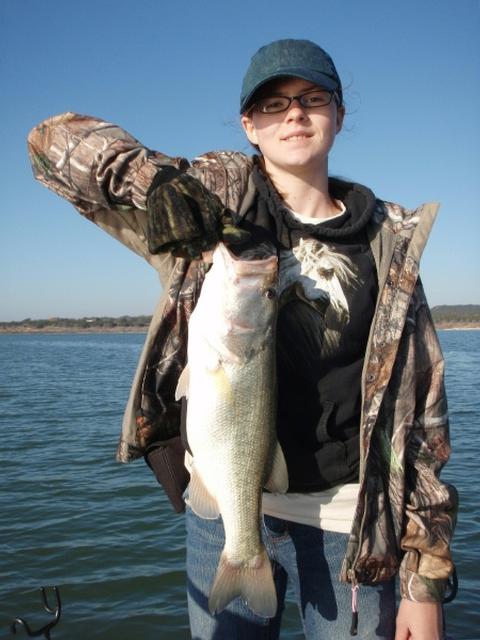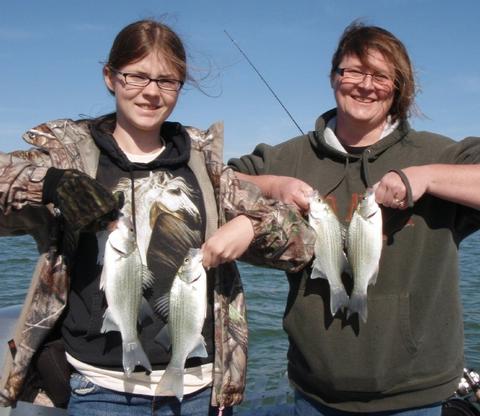The pre-frontal bonanaza continued after a brief mid-day lull from 11:30 to around 2:00p. By now the winds were turning from NNW through to due north, but the winds were high indicating still-changing pressure. The fish responded to that in a big way. This afternoon I had newlyweds Josh and Laura S. of Temple out on the water with me. These two very personable young folks are both pursuing careers in the medical field — Josh is in the midst of a medical school stint at Scott and White, and Laura is pursuing a nursing degree through Temple College.

Josh and Laura were like kids in a candy store today … 154 fish boated in less than 4 hours.
This couple had done a bit of fishing in the past, but most was limited to fishing from the bank with a more traditional approach — bait, bobbers, experimenting with various lures, etc. So, I built on what they already knew and, by trip’s end, had coached them to become quite proficient at working a slab for hungry white bass.
I planned our trip’s start time for 1:30p based on the previous day’s forecast and the timing of the wind shift related to the approaching front. As it turned out, we got on the water a bit early and found little fish activity over the first three areas we searched with sonar. But, by around 2:45p, things began to change as the sun began to work its way towards setting and its intensity decreased a bit. Success came first at Area 700. I found abundant, aggressive white bass ready to feed in 25-27 feet of water, although there was precious little to see on sonar as I made a scouting sweep over the area. Once we got the boat in position, we got slabs down and before I could even utter a single word of instruction, both Laura and Josh were fast to fish — nice foot-long white bass. We stayed in this vicinity, not manuevering beyond Areas 699 or 130 up or down wind for about 45 minutes, and boated fish continuously, winding up with 65 fish taken off this area. All were white bass.
We continued the search, looking over 3-4 areas but seeing little until I did a sonar sweep over Area 145. I saw the trademark winter visual of a few fish hugging close to bottom with little to give away their presence except for a color differential showing on sonar confirmed by the target separation on StructureScan. We got slabs down and immediately I boated a drum and a white bass and Laura likewise landed 2 white bass, then, just as suddenly as it started, the action stopped abruptly. This often happens when a pack of large predator fish move in be it largemouth, gar, or bit catfish, however, these fish often also strike the slabs, get caught or move along and the white bass action resumes, but that was not to be the case here. So, we settled for 4 fish added to the tally for a total of 69 now and moved on.
We again contacted fish at between Areas 033 and 530 and again sonar showed precious little, especially given the high chop on the water’s surface making sonar hard to decipher to begin with. The time was now about 4:00pm and the sunlight was beginning to fail. The combination of decreasing light, significant wave action, and the continuing change in pressure with the front’s arrive combined to form the “perfect storm” to absolutely turn the fish on for one final feed before conditions crash for a few days. Josh and Laura boated exactly 85 fish from a patch of bottom approximately 30 feet in diameter in the final 70 minutes of our trip. We began jigging, but no sooner had the two of them boated a fish or two than the fish began to pull up off the bottom and put the feed bag on. From that point on both of them were able to use a smoking tactic to boat fish after fish. I couldn’t fish if I wanted to as I was busy simple unhooking their fish and quickly getting their slabs back into the water in order to keep the feed alive. Every so often if there was just a slight lull, I’d pitch a slab out away from the boat and walk it back in towards us. That alone would bring “fresh” fish in from beyond the radius that the couple’s slabs were attracting and they would immediately begin to hook up again. Our last fish came at around 5:10, just 10 minutes before sunset. By trip’s end we’d boated exactly 154 fish for our efforts and sent Josh and Laura back to Temple just ecstatic about their successful outdoor experience.
One note to those of you who follow this blog regularly concerning “keeping the feed alive”. You have to understand that white bass area a schooling fish by nature. They are almost always in the presence of others of their kind. Whenever you hook a white bass (especially in the winter when they tend to congregate more heavily and move less than at any other time of the year) you should assume there are other white bass present. It is vitally important to get a bait back down to the schoolmates of a fish you’ve just landed in order to catch more fish. The first fish you catch from a school is very likely to regurgitate food into the water as you reel it in. It is also likely to deficate, and all hooked white bass will struggle and give off vibration and flash. All of these this cause their schoolmates to “turn on”. The trick is to get your presentation back down to those “turned on” fish. If you do this several time, you’ll essentially create a chumline in the the water wherein the area you’re fishing becomes filled with slowly sinking feces and fish parts ejected by the fish you’ve caught. After years of observation in our clear Central Texas reserviors, I’ve seen fish each these things, as well as attempt to steal the lure out of the mouth of hooked fish. This is why tandem rigging can be so effective, allowing an angler to catch 2 fish at a time. So many times I watch fishermen catch a fish, then fool around getting it unhooked, then go and put it in the livewell or snap a photo or whatever, all the while being pushed by the wind off of the spot they were fishing at and away from active fish and, more importantly, letting precious time slip by as the “turned on” fish quickly cool down, settle back to bottom, and become lethargic by default. Something to think about!!
Our water temperature is still hovering right at 60F. If catching white bass or simply learning the jigging and smoking technique so it may be used on other species is of interest to you, the next 3 weeks or so should remain reliable (of course we’ll have to “play the fronts” as the roll in from the north). So, give me a ring and we can work something out. As always, weekdays are best.
TALLY = 154 FISH, all caught and released
The morning trip today, detailed in a separate blog entry, yielded 77 fish for a solo teenaged angler, thus the total number of fish boated today was 231. Pre-frontal fishing is hard to beat!!
TODAY’S CONDITIONS:
Start Time: 1:30pm
End Time: 5:20p
Air Temp: 68F at trip’s start, then falling as cool air began to filter in.
Water Surface Temp: ~60.9F
Wind: Winds swung from NW11 to N14.
Skies: Skies were clear and blue.




